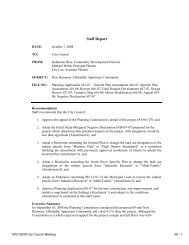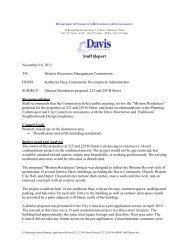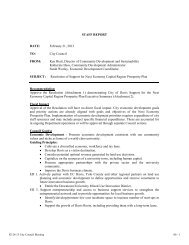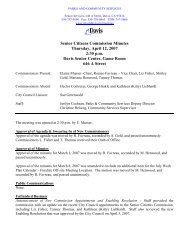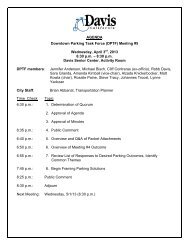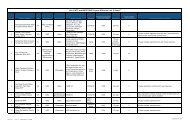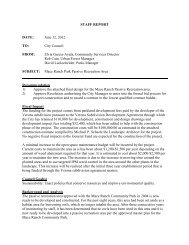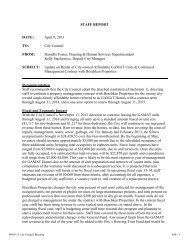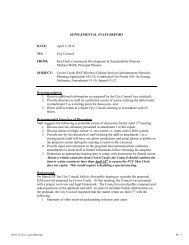10 Draft Integrated Waste Management Plan - City Council - City of ...
10 Draft Integrated Waste Management Plan - City Council - City of ...
10 Draft Integrated Waste Management Plan - City Council - City of ...
You also want an ePaper? Increase the reach of your titles
YUMPU automatically turns print PDFs into web optimized ePapers that Google loves.
2012 Davis <strong>Integrated</strong> <strong>Waste</strong> <strong>Management</strong> <strong>Plan</strong><br />
One <strong>of</strong> the most time consuming elements <strong>of</strong> developing a carryout bag ordinance is compliance with California<br />
Environmental Quality Act (CEQA) in order to reduce future legal liabilities. The CEQA process has been<br />
highly contentious for this issue, with ten different jurisdictions being sued to date by the Save the Plastic Bag<br />
Coalition. Most <strong>of</strong> the lawsuits have been based on allegations that the jurisdictions did not follow the proper<br />
CEQA process. Some <strong>of</strong> the lawsuits are based on the interpretation <strong>of</strong> Proposition 26 as it applies to placing<br />
fees on paper bags. Staff has met with Californians Against <strong>Waste</strong> (CAW) on multiple occasions to discuss<br />
ordinance language, CEQA documentation requirements, and the potential threat <strong>of</strong> litigation.<br />
A carryout bag ordinance is a highly charged political item, as can be seen by the number <strong>of</strong> articles, letters to<br />
the editor and other mentions in the local paper, blogs and community websites in Davis since the potential<br />
ordinance was first announced in the spring <strong>of</strong> 2011. Several issues regarding banning plastic bags are outlined<br />
below.<br />
The 2008 CIWMB <strong>Waste</strong> Characterization Study reported that plastic grocery and other merchandise bags<br />
make up 0.3% <strong>of</strong> the overall waste stream, and 0.6% <strong>of</strong> the residential waste in California (see the figure<br />
below). By weight, this equates to 123,405 and 76,760 tons per year, respectively, state-wide.<br />
TABLE 7-1 COMPOSITION OF GROCERY AND OTHER MERCHANDISE BAGS IN THE WASTE STREAM<br />
Material Type<br />
Paper Grocery and Other<br />
Merchandise Bags<br />
Plastic Grocery and Other<br />
Merchandise Bags<br />
Overall<br />
<strong>Waste</strong><br />
Stream<br />
Commercial<br />
<strong>Waste</strong><br />
Residential<br />
<strong>Waste</strong><br />
0.4% 0.4% 0.5%<br />
0.3% 0.2% 0.6%<br />
The pie chart below shows 20<strong>10</strong> DWR collection data on the various waste streams in comparison to the plastic<br />
bags component to show the effect <strong>of</strong> plastic bags on the waste stream in Davis (assuming that plastic bags<br />
make up 0.6% <strong>of</strong> the residential waste stream).<br />
FIGURE 7-1 PLASTIC BAG IMPACT ON 20<strong>10</strong> DAVIS WASTE STREAM<br />
DRAFT<br />
Recycling<br />
14.6%<br />
Compost<br />
25.1%<br />
Landfilled<br />
Drop Boxes<br />
11.3%<br />
C&D 3.7%<br />
Plastic Bags<br />
0.1%<br />
Residential<br />
Garbage<br />
19.9%<br />
Commercial<br />
Garbage<br />
25.2%<br />
Page | 7-60



